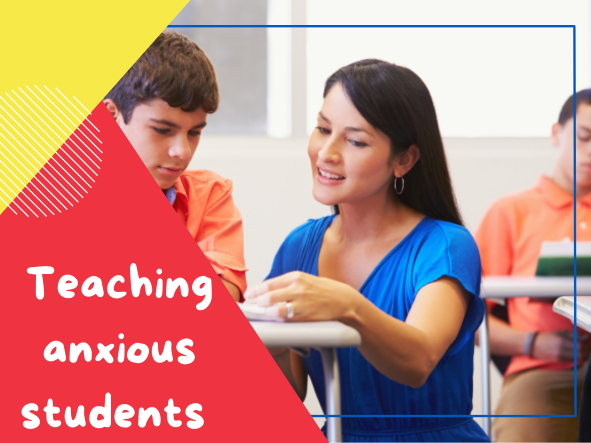Teaching Tips for Helping Anxious Students
Anxiety has become the most common mental health disorder seen in children and adolescents. It comes in many forms with different outward symptoms. School and school activities often exacerbate anxiety.
Anxiety experienced by an individual range from a fear of tests and exams to the sheer terror of human interaction. Anxiety is closely linked with depression. Anxiety and depression in any form or intensity can negatively impact a student and their performance in the classroom.
What can teachers do to help anxious and struggling students?
I personally struggle with anxiety. Having Generalized Anxiety Disorder keeps school interesting if nothing else for me.
In this article, I share ways teachers have helped me lessen my panic-inducing fears and things I wish they knew. These suggestions are generic. However, students are unique and so are their anxieties. What works for one student may not work for another.
Talking to anxious students before meltdowns is the best way to understand how to help reduce their anxiety in your classroom and calm them during a crisis.
Tip One: Recognition
A little stress in the classroom is normal, especially during tests and quizzes. Extreme scrutiny and worry over every half-point on an assignment is not. Anxiety manifests in many different ways but may only be identified if one looks closely.
Common anxiety symptoms include;
- Concentration issues
- Avoiding participation in class
- Being disruptive
- Perfectionism
- Avoiding social interactions
- Frequent trips to the nurse or the bathroom
Any of these symptoms could indicate an abnormal level of student anxiety.
Tip Two: Realize Students Are Busy
Students juggle classes, homework, extracurriculars, and work outside of school. Everything a student does must be squeezed into 24-hour increments across seven days and then repeated.
In my senior year of high school, I struggled to handle multiple AP classes, college applications, and 14 plus hours a week of intense dance training plus 6 additional hours of Saturday performance rehearsals. For religious purposes, I choose not to do homework on Sundays. I often felt as if my teachers did not understand my time crunch.

For my anxiety, one of the most helpful things is simple. I feel better when I know someone else knows I have an intense schedule.
When a person in the room sees and recognizes an anxious person has a long to-do list, it is positively relieving for them. It doesn’t matter if the workload lightens. It is the awareness and compassion that counts.
Teachers, of course, still need to hand out assignments. And students still need to do them. However, having a friendly face in the room eases anxious fears versus dealing with a teacher who couldn’t care less how much is on the student’s plate.
Tip Three: Sleep
Students’ busy schedules often lead to reduced sleep. The Center for Disease Control and Prevention conducted a study on students and sleep. They determined that 57.8% of middle school students and 72.7% of high school students did not get enough sleep on school nights. Children 6 to 12 years of old need at least 9 hours of sleep. and teenagers 13-18 need at least 8 hours.

From my experience, a lack of sleep worsens my anxiety. Every little detail becomes a Mount Everest to conquer. Busy schedules lead to less sleep. Less sleep leads to uncontrollable emotions.
Knowing teenagers are chronically sleep-deprived may help you to understand outbursts or panic attacks in the classroom. Even students without a diagnosable anxiety disorder may experience a sharp increase in anxious feelings when chronically sleep-deprived.
To help every student enter the classroom with a clear head ready for work, remind them of the importance of sleep. Encourage other healthy behaviors, too.
Tip Four: Addressing Concerns in the Classroom
Every student should feel comfortable in the classroom. Teachers are responsible for promoting a safe and stable learning environment where students are unafraid to approach the teacher with concerns or questions.
For an anxiety-ridden child, it can take every ounce of courage they have just to stand in front of the teacher’s desk. In light of this, concerns should be treated with courtesy and respect regardless of the question or the answer. Students should feel acknowledged and listened to even if a negative response is appropriate.

Treat every student who approaches you as one who may have anxiety. Listen to their concerns, and if possible, make accommodations. Don’t dismiss them, but do not bend to their every whim either. Acknowledge your student’s worries even if you can’t change anything to help them.
Simply knowing a teacher will not be angry if they have a concern decreases student anxiety.
Tip Five: Do Not Draw Attention to Anxious Behavior
What should a teacher do if their student has a mental breakdown in the middle of class?
DO NOT DRAW ATTENTION TO THEM!
Drawing attention to an anxious student only augments the symptoms. When I have a panic attack, all I want to do is to disappear.
So, what can you do? The solution is different for every individual. If you know the student well, you may already know the answer.
If you don’t know where to start, try approaching them at a time when the rest of the class is not watching. Offer a bathroom pass or a pass to visit the guidance counselor. This gives them an escape from the scary situation without drawing attention to the episode. You can also ask the student what they need and be patient while they struggle to find the words to explain.
Don’t assume to know what is wrong or what the trigger was. However, feel free to ask the student for further clarification.
It takes a great deal of resilience for a student to continually face their fears every day in the classroom. I have learned through my experience that it takes special and amazing people to consistently interact well with anxiety-ridden children. These people can make all the difference.
You can be the difference that changes a student’s outlook on the classroom. Be patient when working with anxious students. Remember, the chance to see them succeed and overcome their fears is worth it in the end.
Teacher Power is Compassionate
Handling anxiety-ridden students is exhausting, and you may need a little help to maintain your energy. With six delectable flavors to choose from, Teacher Power Energy Drinks offer you the boost you need to face your class, their antics, and their anxieties. Our drinks are sugar-free, low-calorie, and budget friendly.

You got this with Teacher Power in your mug! Visit our website today!
By: Lela J. Haroldsen
The content of Teacher Power’s website is for information only, not advice or guarantee of outcome. Information is gathered and shared from reputable sources; however, Teacher Power is not responsible for errors or omissions in reporting or explanation. No individuals, including those taking Teacher Power products, should use the information, resources or tools contained within to self-diagnosis or self-treat any health-related condition. Teacher Power gives no assurance or warranty regarding the accuracy, timeliness or applicability of the content.
Sources:
Suni, Eric. “Anxiety and Sleep.” Sleep Foundation. 2020. https://www.sleepfoundation.org/mental-health/anxiety-and-sleep
“Mental Health Disorders in Adolescents.” American Colleges of Obstetricians and Gynecologists. 2017. https://www.acog.org/clinical/clinical-guidance/committee-opinion/articles/2017/07/mental-health-disorders-in-adolescents
“6 signs of anxiety in students for teachers to lookout for.” Gheorg. 2021. https://www.gheorg.com/blog/signs-anxiety-student-teachers
“Sleep in Middle and High School Students.” Centers for Disease Control and Prevention. 2020. https://www.cdc.gov/healthyschools/features/students-sleep.htm

